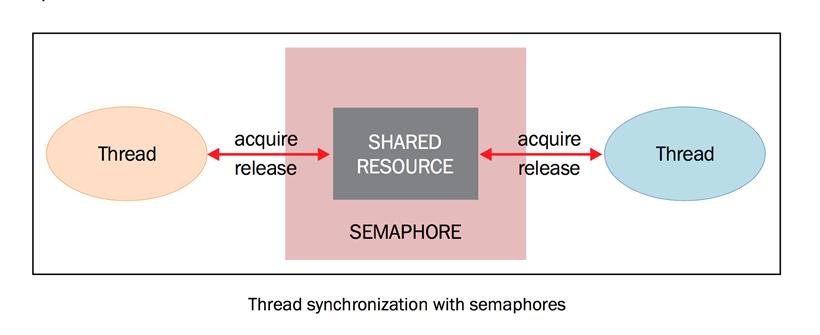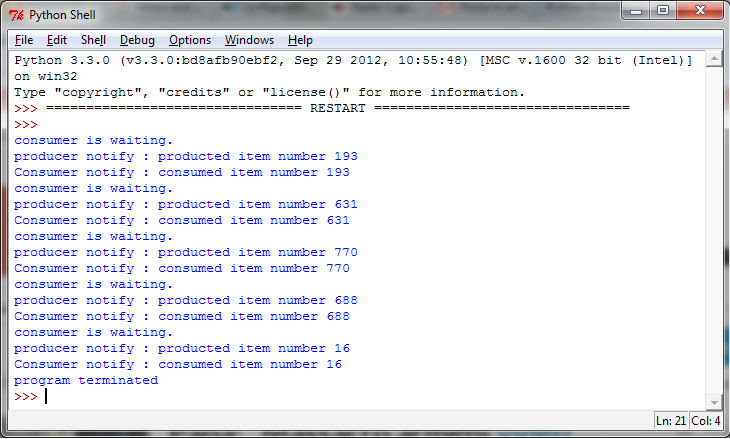-
2.8 使用信号量进行线程同步
-
信号量由E.Dijkstra发明并第一次应用在操作系统中,信号量是由操作系统管理的一种抽象数据类型,用于在多线程中同步对共享资源的使用。本质上说,信号量是一个内部数据,用于标明当前的共享资源可以有多少并发读取。
同样的,在threading模块中,信号量的操作有两个函数,即 acquire() 和 release() ,解释如下:
1.每当线程想要读取关联了信号量的共享资源时,必须调用 acquire() ,此操作减少信号量的内部变量, 如果此变量的值非负,那么分配该资源的权限。如果是负值,那么线程被挂起,直到有其他的线程释放资源。
2当线程不再需要该共享资源,必须通过 release() 释放。这样,信号量的内部变量增加,在信号量等待队列中排在最前面的线程会拿到共享资源的权限。

虽然表面上看信号量机制没什么明显的问题,如果信号量的等待和通知操作都是原子的,确实没什么问题。但如果不是,或者两个操作有一个终止了,就会导致糟糕的情况。
举个例子,假设有两个并发的线程,都在等待一个信号量,目前信号量的内部值为1。假设第线程A将信号量的值从1减到0,这时候控制权切换到了线程B,线程B将信号量的值从0减到-1,并且在这里被挂起等待,这时控制权回到线程A,信号量已经成为了负值,于是第一个线程也在等待。
这样的话,尽管当时的信号量是可以让线程访问资源的,但是因为非原子操作导致了所有的线程都在等待状态。
准备工作
下面的代码展示了信号量的使用,我们有两个线程, producer() 和 consumer() ,它们使用共同的资源,即item。 producer() 的任务是生产item, consumer() 的任务是消费item。
当item还没有被生产出来, consumer() 一直等待,当item生产出来, producer() 线程通知消费者资源可以使用了。
如何做
在以下的代码中,我们使用生产者-消费者模型展示通过信号量的同步。当生产者生产出item,便释放信号量。然后消费者拿到资源进行消费。
# -*- coding: utf-8 -*- """Using a Semaphore to synchronize threads""" import threading import time import random # The optional argument gives the initial value for the internal # counter; # it defaults to 1. # If the value given is less than 0, ValueError is raised. semaphore = threading.Semaphore(0) def consumer(): print("consumer is waiting.") # Acquire a semaphore semaphore.acquire() # The consumer have access to the shared resource print("Consumer notify : consumed item number %s " % item) def producer(): global item time.sleep(10) # create a random item item = random.randint(0, 1000) print("producer notify : produced item number %s" % item) # Release a semaphore, incrementing the internal counter by one. # When it is zero on entry and another thread is waiting for it # to become larger than zero again, wake up that thread. semaphore.release() if __name__ == '__main__': for i in range (0,5) : t1 = threading.Thread(target=producer) t2 = threading.Thread(target=consumer) t1.start() t2.start() t1.join() t2.join() print("program terminated")程序会运行5轮,结果如下:

讨论
信号量被初始化为0,此信号量唯一的目的是同步两个或多个线程。在这里,我们的线程必须并行运行,所以需要信号量同步:
semaphore = threading.Semaphore(0)
这个操作和lock中的机制非常相似, producer() 完成创建item之后,释放资源: :
semaphore.release()
信号量的 release() 可以提高计数器然后通知其他的线程。同样的, consumer() 方法可以通过下面的方法拿到资源: :
semaphore.acquire()
如果信号量的计数器到了0,就会阻塞 acquire() 方法,直到得到另一个线程的通知。如果信号量的计数器大于0,就会对这个值-1然后分配资源。
最后,拿到数据并打印输出: :
print("Consumer notify : consumed item number %s " % item)
了解更多
信号量的一个特殊用法是互斥量。互斥量是初始值为1的信号量,可以实现数据、资源的互斥访问。
信号量在支持多线程的编程语言中依然应用很广,然而这可能导致死锁的情况。例如,现在有一个线程t1先等待信号量s1,然后等待信号量s2,而线程t2会先等待信号量s2,然后再等待信号量s1,这样就可能会发生死锁,导致t1等待s2,但是t2在等待s1。
- 留下你的读书笔记
- 你还没登录,点击这里
-
用户笔记留言

